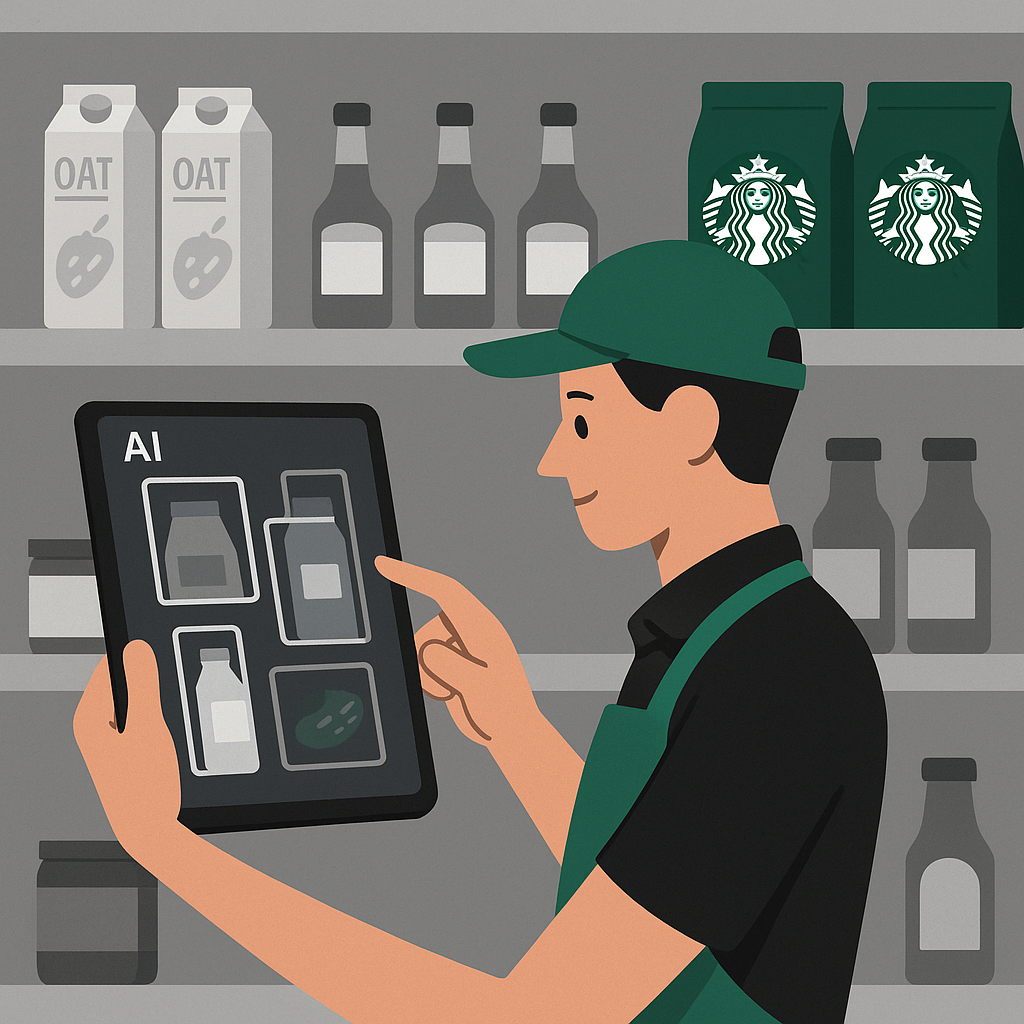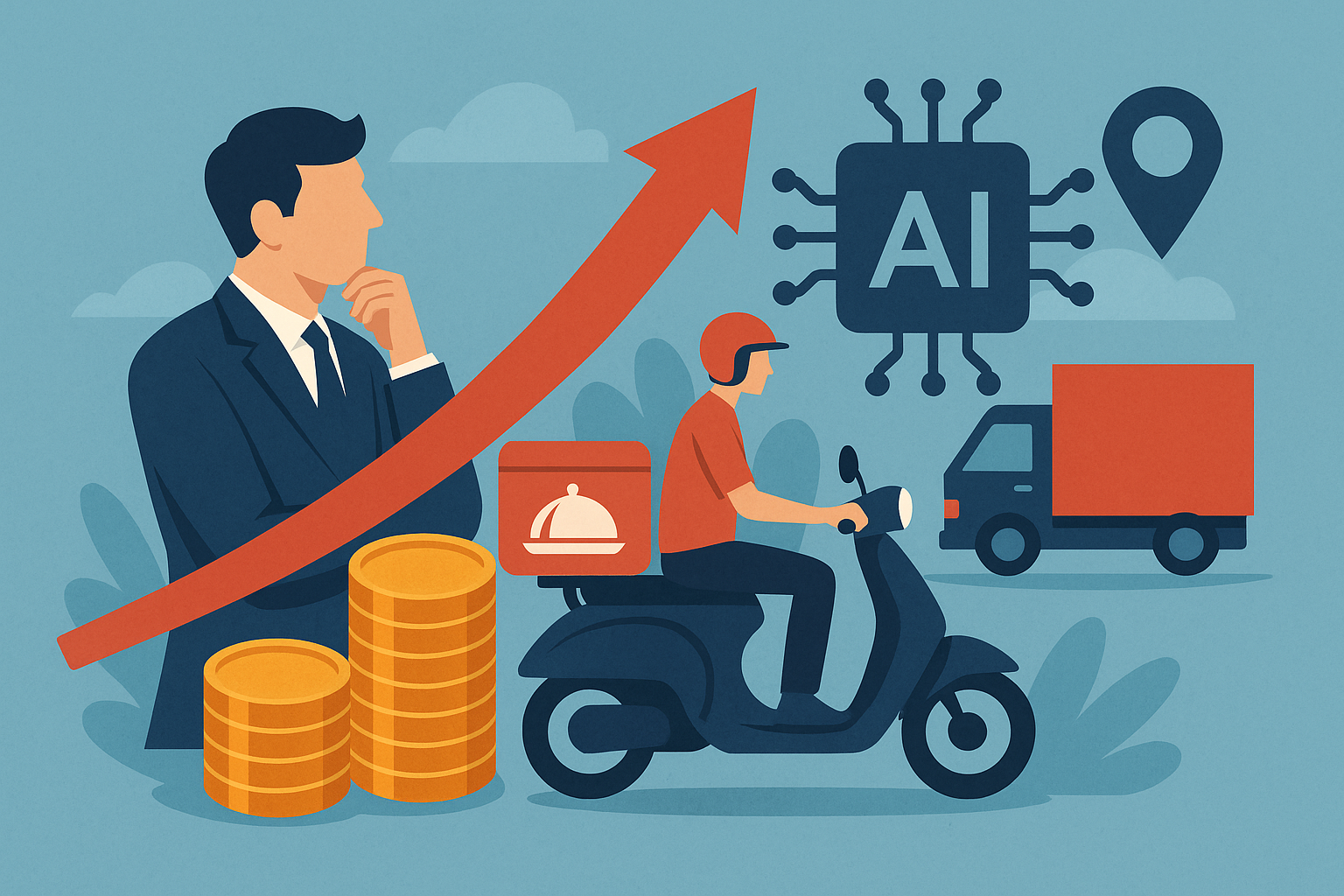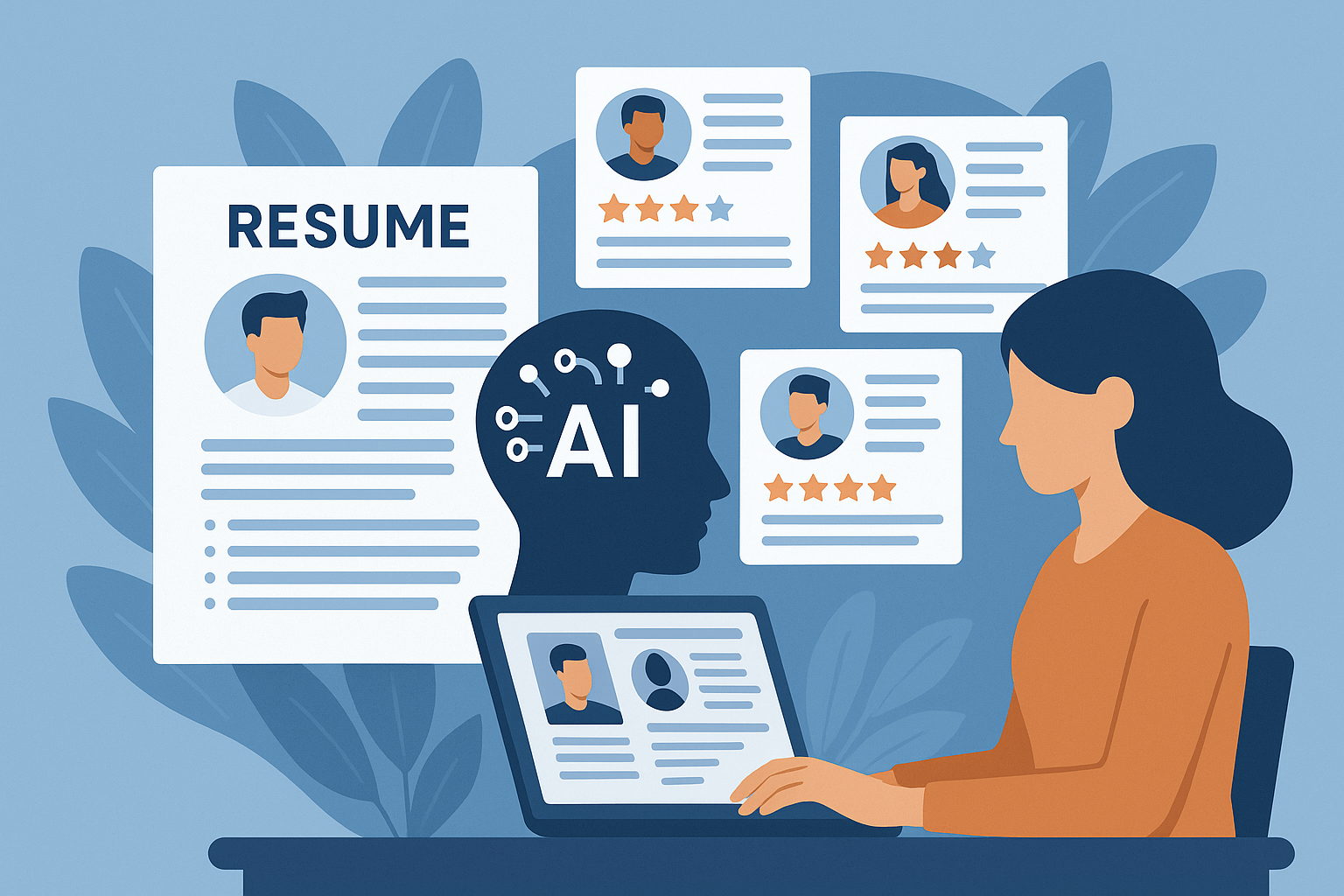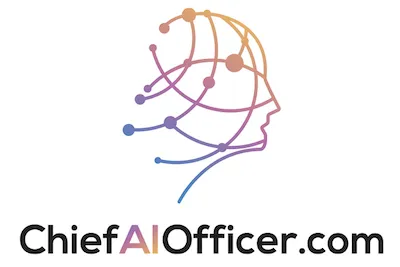Starbucks baristas used to spend hours manually counting inventory: physically touching every carton of oat milk, every bottle of caramel drizzle, every bag of coffee beans, writing numbers on clipboards, then entering data into computer systems. A typical store inventory took 2-3 hours of labor, happened weekly at best, and frequently contained counting errors that led to stockouts or overordering.
Now baristas scan shelves with handheld tablets equipped with computer vision AI. The system automatically counts inventory in minutes, happens up to eight times more frequently than manual methods, and flags items running low before stockouts occur. When oat milk supplies drop below threshold levels, the system triggers restock orders automatically while baristas continue serving customers rather than counting cartons in back rooms.
The counterintuitive revelation: Starbucks’ biggest inventory problem wasn’t supply chain logistics or demand forecasting accuracy. It was knowing what they actually had on hand at any given moment. You can’t restock effectively if you don’t know you’re running low until customers start complaining that items aren’t available. AI didn’t optimize the supply chain. It made the supply chain visible in real-time.
The Oat Milk Stockout Crisis
Oat milk represents Starbucks’ perfect storm inventory challenge: rapidly growing demand, limited supplier capacity, temperature-sensitive storage requirements, and short shelf life. When oat milk runs out, customers who specifically chose Starbucks for oat milk options either settle for less-preferred alternatives or leave to find competitors with availability.
The business impact of oat milk stockouts extends beyond just lost beverage sales. A customer wanting an oat milk latte who finds it unavailable might skip their purchase entirely rather than accept regular milk. That’s not just lost beverage revenue. It’s lost food attachment sales (the pastry they would have bought with their latte), future visit frequency reduction (they’ll remember Starbucks didn’t have what they wanted), and potential permanent switching to competitors who reliably stock oat milk.
Traditional inventory management couldn’t prevent these stockouts because of information latency. Stores conducted physical inventory counts weekly, discovered oat milk was running low, placed restock orders, then waited for delivery. During the 3-5 days between discovering low inventory and receiving replenishment, stores frequently ran completely out as demand continued.
The weekly inventory cycle also created systematic under-ordering. Store managers couldn’t see real-time demand patterns, so they based orders on average historical usage. When demand spiked (warmer weather driving cold beverage orders, local events increasing foot traffic, or viral social media posts popularizing oat milk drinks), stores ran out before the next inventory count revealed the need for increased ordering.
Manual counting errors compounded the problem. A barista counting dozens of oat milk cartons at 6am before shift start might miscount by 2-3 units. That seems trivial until you realize those 2-3 cartons represent 50-75 oat milk lattes. Small counting errors created large customer-facing stockouts because the margin between adequate supply and running out was often just a few cartons.
Starbucks needed real-time visibility into what inventory existed at each store right now, not what existed when someone last counted a week ago. Only with accurate current data could they identify stockouts before they happened and trigger replenishment fast enough to prevent disappointed customers.
The Computer Vision Counting System
Starbucks deployed handheld tablets running AI-powered software that uses computer vision, 3D spatial intelligence, and augmented reality to automate inventory counting. Baristas scan storage areas with the tablet camera, and the system automatically identifies products and counts quantities visible in the frame.
The computer vision system trained on images of Starbucks’ specific products can recognize oat milk cartons, caramel bottles, coffee bags, and hundreds of other items based on packaging appearance. The 3D spatial intelligence allows it to understand depth and estimate quantities even when items are stacked or partially visible. The augmented reality overlay provides real-time feedback showing which items the system has counted and which areas need scanning.
The practical workflow becomes: a barista takes the tablet into the storage area, scans each section while the system automatically identifies and counts products, reviews the automatically generated inventory list to verify accuracy, then submits the count. What previously took 2-3 hours of tedious manual counting now takes 15-20 minutes of tablet scanning.
The accuracy improvement matters as much as the speed improvement. Computer vision doesn’t get tired, distracted, or make arithmetic errors. When it counts 23 oat milk cartons, that count is accurate. Manual counts by tired baristas at the end of long shifts frequently contained errors that led to incorrect ordering decisions.
The system also captures data about product placement, expiration dates, and storage conditions that manual counting typically missed. If oat milk cartons are stored in ways that affect their visibility to the scanning system, that provides feedback about storage organization problems. If products near expiration aren’t getting used, the system flags potential waste before it occurs.
I’ve observed similar dramatic efficiency improvements in warehouse management where AI-powered inventory scanning reduced count times by 70-80% while simultaneously improving accuracy. The humans conducting manual counts weren’t incompetent. They were being asked to do tedious work that computers handle far more reliably.
The 8x Frequency Transformation
Reducing inventory count time from 2-3 hours to 15-20 minutes enables fundamentally different inventory management. When counting takes hours of labor, stores limit frequency to weekly or bi-weekly to control labor costs. When counting takes 15 minutes, stores can conduct inventory multiple times per week or even daily for high-velocity items.
Starbucks reports conducting inventory counts up to eight times more frequently than traditional methods. This frequency transformation provides near-real-time visibility into inventory levels, enabling proactive rather than reactive restocking.
Consider oat milk specifically. Under weekly inventory cycles, a store might discover on Monday that oat milk is running low, place a restock order, and receive delivery Wednesday. But if demand spiked over the weekend and the Monday count revealed only a day’s supply remaining, the store runs out Tuesday before the Wednesday delivery arrives.
With daily or multiple-per-day counting, the store identifies declining oat milk inventory earlier in its depletion cycle. Instead of discovering “we have one day of supply left,” they discover “we’re using oat milk faster than normal and will run out in three days if the pattern continues.” This early warning provides sufficient lead time for emergency restocking before customer-facing stockouts occur.
The frequent counting also reveals demand patterns invisible in weekly snapshots. Discovering that oat milk inventory drops significantly every Wednesday suggests midweek demand drivers (perhaps nearby office workers treating themselves mid-week). This granular pattern recognition enables smarter ordering that anticipates predictable demand variations.
The labor economics work because the time saved per count outweighs the cost of more frequent counting. A manual inventory taking 2.5 hours of barista time costs roughly $30-40 in labor. An AI-assisted inventory taking 20 minutes costs $4-6 in labor. Even conducting inventory daily costs less total labor than weekly manual counts while providing dramatically better visibility.
The Demand Forecasting Integration
The AI inventory system doesn’t just count what’s on shelves currently. It integrates with demand forecasting algorithms that predict future consumption based on historical patterns, weather forecasts, local events, and other factors affecting beverage demand.
Weather particularly impacts Starbucks demand patterns. Hot days drive cold beverage sales that consume more oat milk for iced lattes, cold foam drinks, and other cold menu items. The AI can observe current inventory levels, check weather forecasts predicting 90°F temperatures tomorrow, and flag that current oat milk stock will be insufficient to meet projected demand.
Local events also affect demand unpredictably. A concert, sports event, or conference near a store can triple normal foot traffic for that day. Traditional inventory management couldn’t account for these one-time spikes because they don’t appear in historical patterns. AI-powered systems can ingest event calendar data and adjust forecasts accordingly.
Social media trends create particularly challenging demand volatility. A viral TikTok featuring a specific Starbucks drink can spike demand for ingredients used in that drink within days. Traditional inventory planning based on historical averages can’t respond fast enough to these viral phenomena. AI monitoring social media signals can detect brewing trends and adjust forecasting before the full demand spike hits.
The integration between real-time inventory visibility and predictive demand forecasting creates a closed loop. The system knows current inventory levels, predicts upcoming demand, calculates whether current stock will be sufficient, and triggers restock orders with appropriate urgency. This automation removes human judgment bottlenecks where store managers must manually assess whether they need to order more of specific items.
The Barista Time Liberation
Eliminating 2-3 hours of weekly inventory counting per store liberates substantial barista time for customer-facing activities. Across Starbucks’ 11,000+ US stores, this represents roughly 25,000-33,000 hours weekly or 1.3-1.7 million hours annually recaptured from back-room inventory counting.
The recaptured time matters beyond just the raw hours. Inventory counting typically happens during off-peak hours when fewer customers are in stores, but it still removes baristas from the floor during times when they could be cleaning, restocking customer-facing areas, or preparing for rush periods. Having that time available for other activities improves overall store operations.
More importantly, inventory counting represented tedious work that contributed to barista job dissatisfaction. Spending hours in back rooms counting products isn’t why people become baristas. They want to make beverages, interact with customers, and create positive experiences. Automating the tedious inventory work improves job satisfaction by letting baristas focus on more fulfilling aspects of their roles.
The freed time also enables better customer service during peak periods. When a morning rush hits, every available barista matters. Having someone complete inventory in 15 minutes versus 2-3 hours means more baristas available on the floor during busy periods, reducing wait times and improving customer experience.
The system also reduces the cognitive burden on store managers who previously had to remember to conduct inventory, schedule it around operations, and ensure accuracy. Automated reminders and streamlined workflows make inventory management a 15-minute task rather than a multi-hour operational challenge requiring careful planning.
The Supply Chain Optimization Layer
Accurate real-time inventory data across thousands of stores enables supply chain optimization impossible with weekly manual counts. When Starbucks’ central supply chain systems can see actual inventory levels at every location continuously, they can optimize distribution and logistics far more effectively.
Traditional supply chain optimization relied on scheduled orders from stores based on manager estimates. Store managers would assess their inventory, estimate what they needed, and place orders. This decentralized approach meant the central supply chain had limited visibility into actual demand patterns and couldn’t optimize delivery routes or warehouse inventory based on real needs.
With centralized visibility into inventory levels across all stores, the supply chain can identify regions experiencing unusual demand, redistribute inventory from overstocked to understocked locations, and adjust delivery schedules to prioritize stores approaching stockouts. This network-level optimization reduces aggregate inventory costs while improving product availability.
The system can also identify supply chain problems before they cascade. If multiple stores in a region are depleting oat milk inventory faster than normal, that might indicate a distribution problem where deliveries are delayed. Early identification enables proactive intervention before stockouts spread across the region.
The logistics optimization extends to delivery route planning. When the system knows which stores need urgent restocking versus which have adequate inventory, delivery routes can prioritize urgent needs. A truck approaching multiple stores might visit the one running low on oat milk first rather than following a preset route that risks arriving after stockouts occur.
The Waste Reduction Benefit
Improved inventory visibility reduces waste from overordering and expired products. When stores can’t see current inventory accurately, they tend to over-order as insurance against stockouts. This creates waste when excess inventory expires before use, particularly for perishables like milk products with limited shelf life.
Oat milk presents particular waste challenges because it requires refrigeration and has a shelf life measured in weeks rather than months. Over-ordering by even a small margin creates waste when older cartons expire before use. Under traditional inventory management, stores couldn’t optimize ordering precisely enough to balance stockout risk against waste risk.
Real-time inventory visibility allows more precise ordering that reduces safety stock margins. When stores know exactly what they have and can reorder with confidence that replenishment will arrive before stockouts, they can carry lower inventory levels without increasing stockout risk. This reduces capital tied up in inventory while simultaneously reducing waste from expiration.
The system also flags products approaching expiration dates, enabling proactive use before waste occurs. Store managers receive alerts about oat milk cartons nearing expiration, allowing them to use older inventory first and potentially offer promotions to move products before they expire. This active expiration management reduces waste that happened when products expired unnoticed in storage areas.
The economic impact of waste reduction compounds across thousands of stores. If each store reduces oat milk waste by even 2-3 cartons weekly through better inventory management, that’s 25,000-30,000+ cartons annually across the chain. At $4-5 per carton wholesale cost, that’s $100,000-150,000 in direct waste reduction plus the environmental benefits of reduced food waste.
The Customer Experience Impact
The ultimate goal isn’t operational efficiency or cost reduction. It’s ensuring customers can order what they want when they want it. Stockouts create negative experiences that affect customer satisfaction, loyalty, and future visit frequency.
A customer who wants an oat milk latte but finds oat milk unavailable faces several bad options: accept a substitute they don’t prefer, order something different entirely, or leave to find another location with availability. All three options create dissatisfaction. The customer either gets something they don’t want or doesn’t get their Starbucks purchase at all.
The brand impact extends beyond individual transactions. Customers remember negative experiences more vividly than positive ones. A single stockout might cause a customer to start checking availability before visiting or switching to competitors they perceive as more reliable. The lifetime value loss from customer switching substantially exceeds the immediate lost transaction value.
Social media amplifies stockout impacts. Customers frustrated by stockouts often share their experiences on social platforms, creating negative publicity that affects potential customers who haven’t personally experienced problems. A viral post about Starbucks never having oat milk creates perception problems far beyond the actual frequency of stockouts.
Improving availability through better inventory management directly addresses these customer experience issues. When oat milk is consistently available because the system identifies and prevents stockouts proactively, customer satisfaction improves, loyalty strengthens, and negative social media decreases.
The improved experience also enables revenue from customers who would have left if their preferred option wasn’t available. A customer who finds oat milk in stock because AI inventory management prevented stockouts represents captured revenue that would have been lost under traditional management.
The Scalability Across Locations
Deploying AI inventory management across 11,000+ stores demonstrates scalability that many AI initiatives struggle to achieve. Enterprise AI often succeeds in pilots but fails when expanding to production scale across diverse locations.
Starbucks’ stores vary dramatically in size, layout, inventory levels, and operational patterns. Urban stores with limited storage space operate differently from suburban locations with larger back-room areas. High-volume stores near transit hubs face different challenges than lower-volume neighborhood locations. The AI system must work across this diversity rather than just in idealized pilot locations.
The tablet-based approach creates deployment simplicity compared to alternatives requiring installed equipment or facility modifications. Starbucks can deploy the system by providing tablets and training rather than conducting physical infrastructure upgrades at each location. This dramatically reduces deployment costs and timeline compared to fixed scanning infrastructure.
The system also accommodates varying barista technical proficiency. Some locations employ tech-savvy baristas comfortable with new technology. Others have staff less experienced with digital tools. The interface must be intuitive enough that all baristas can use it effectively regardless of prior technical experience.
The scalability success provides validation that the technology works in real operational conditions across diverse environments rather than just controlled pilot scenarios. This gives confidence that continued expansion and enhancement will succeed rather than encountering unforeseen problems at scale.
The Competitive Differentiation
Starbucks’ investment in AI inventory management creates operational advantages competitors struggle to match. Independent coffee shops lack resources for sophisticated AI systems. Regional chains might not achieve the scale necessary to justify custom development. Even major competitors face challenges implementing comparable capabilities.
The operational efficiency advantages compound over time. Better inventory management reduces costs through lower waste and improved labor allocation. These cost savings can fund additional technology investments or price competitiveness. The improved customer experience from better availability drives loyalty and visit frequency advantages that generate revenue growth.
The data advantages also compound. As Starbucks accumulates years of high-frequency inventory and demand data, their forecasting models become increasingly accurate. Competitors starting similar initiatives lack this accumulated training data, meaning their systems will perform worse even using comparable technology.
The technology talent advantages matter too. Starbucks’ reputation as a technology-forward retailer helps attract technical talent that might otherwise work for pure technology companies. This talent advantage accelerates innovation and ensures Starbucks can continue advancing their capabilities faster than competitors.
The Implementation Complexity Reality
Deploying AI inventory management at scale required substantial investment and effort beyond just buying tablets and software. Understanding this complexity matters for organizations considering similar transformations.
The computer vision models needed training on Starbucks’ specific products across varying lighting conditions, storage configurations, and visual obstructions. Generic object recognition doesn’t work sufficiently well. The models must reliably identify and count products in the messy real-world conditions of store back rooms.
Integration with existing inventory management and ordering systems required substantial IT work. The AI counting system can’t operate in isolation. It must feed data into systems that track inventory, generate orders, manage logistics, and report results. These integrations across legacy systems represent significant technical challenges.
Change management across thousands of stores and tens of thousands of baristas required extensive training programs, ongoing support, and continuous feedback collection to refine the system. Technology deployment succeeds or fails based on human adoption, not just technical capability.
The implementation likely took 12-18 months from initial pilot to full deployment across all stores. Organizations expecting rapid implementation of similar initiatives should plan for sustained multi-year efforts rather than quick deployments.
Your Strategic Response Path
For retailers facing similar inventory visibility challenges, Starbucks’ approach demonstrates that AI-powered inventory management delivers measurable operational and customer experience improvements. The technology exists, the business case is proven, and the implementation path is understood.
Start by quantifying current inventory management costs: labor hours spent counting, stockout frequency and impact, waste from overordering, and capital tied up in excess inventory. This establishes the baseline for measuring improvement and justifying investment.
Evaluate AI inventory solutions based on accuracy, speed, ease of use, and integration capabilities with existing systems. The technology must work reliably in real operational conditions, not just demonstrations. Pilot testing in diverse locations reveals whether solutions work across varying environments.
Plan for change management as seriously as technology deployment. The system only delivers value if staff actually use it effectively. Training, ongoing support, and continuous feedback collection ensure adoption succeeds. Technology that sits unused because staff revert to familiar manual methods wastes the entire investment.
Integrate inventory visibility with demand forecasting and automated ordering to capture full value. Real-time inventory data is valuable, but automatically triggering appropriate actions based on that data delivers the true operational impact.
The Future of Retail Operations
Retail operations are shifting from periodic snapshots to continuous real-time visibility across all operational metrics. Inventory represents just one example. Labor scheduling, equipment maintenance, product placement, and customer flow will all benefit from similar AI-powered continuous monitoring and optimization.
Starbucks proved that these transformations deliver measurable value in complex real-world operations across thousands of locations. The question isn’t whether AI will transform retail operations. It’s whether your organization will lead or follow in capturing these operational improvements.
Counting inventory eight times faster while eliminating manual labor and preventing stockouts isn’t revolutionary technology. It’s solving mundane operational problems that were always there but that traditional approaches couldn’t economically address.




